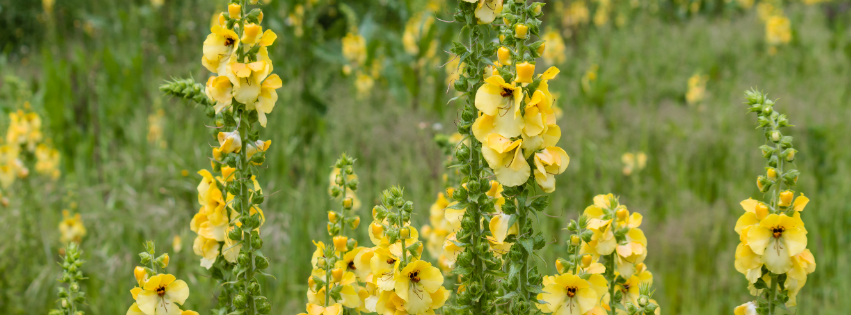Weed of the Month: Common Mullein
We’re highlighting an uncommon annoyance for this Weed of the Month: the common mullein. This invasive plant grows big and tall, spreading countless long-lived seeds that can outcompete native plants. Fighting an infestation can be tough, but we know how to give you an edge.
.png)
Common Mullein Origins:
Common mullein (Verbascum thapsus L.) came to North America from Eurasia by way of European settlers in the mid-1700s, most likely as thanks to its various medicinal properties. But just because this pest has a silver lining doesn’t mean you should give it a pass.
Common Mullein: Plant Description
Common mullein is a biennial to short-lived perennial forb, growing from a taproot to form a cabbage-like basal rosette in its first year, and producing a single stem that can reach up to 10 feet tall in the second. Its leaves are gray-green, oblong/oblanceolate, and decrease in size as they alternate up the stem. Leaves are 4 to 12 inches long, 1 to 5 inches wide, and covered in dense, wooly hairs.
Common mullein flowers from mid-spring to late summer with small, yellow, 5 petaled flowers on spike-like racemes. The woody spikes can persist for years after the plant has died, lending to its hardiness.
Common Mullein Habitat
Common mullein prefers dry, sandy or gravelly soils, but it can grow almost anywhere, including neglected meadows and lots, roadsides, forest openings, industrial areas, and more. They can cause the biggest problems in pastures, where they can spread quickly, outcompeting more beneficial plants. Since their wooly leaves are unpalatable to livestock, this greatly reduces the grazing value of land.
Common Mullein Growth
Generally, common mullein has a two season cycle of growth. The first is when the taproot and rosette sprouts, the second is when the tall stalk rapidly grows and produces flowers that spread small, dark seeds. Plants can produce up to 180,000 seeds, which can live for decades in the ground, helping infestations stick around.
Common Mullein Management
Stopping common mullein before it can take hold with prevention and cultural control methods is always the best first step. Manual removal of the taproot can help reduce existing plants, although soil disturbance can stimulate the seeds. Mowing is only effective if continued throughout the entire growing season or coupled with herbicide treatments and should not be done while seeds are present.
Grazing isn’t effective since livestock avoid the leaves, but seed head weevil is an effective biological control method Teton County.
Larger infestations can be controlled with spring and fall herbicides treatments on the rosettes, although treating bolting plants can be effective. You can also chop flowering plants and treat the remaining rosette and stem with herbicide to prevent reflowering.
Read the label before using any herbicide. Contact TCWP if you have any questions about application rates or how to use an herbicide.
